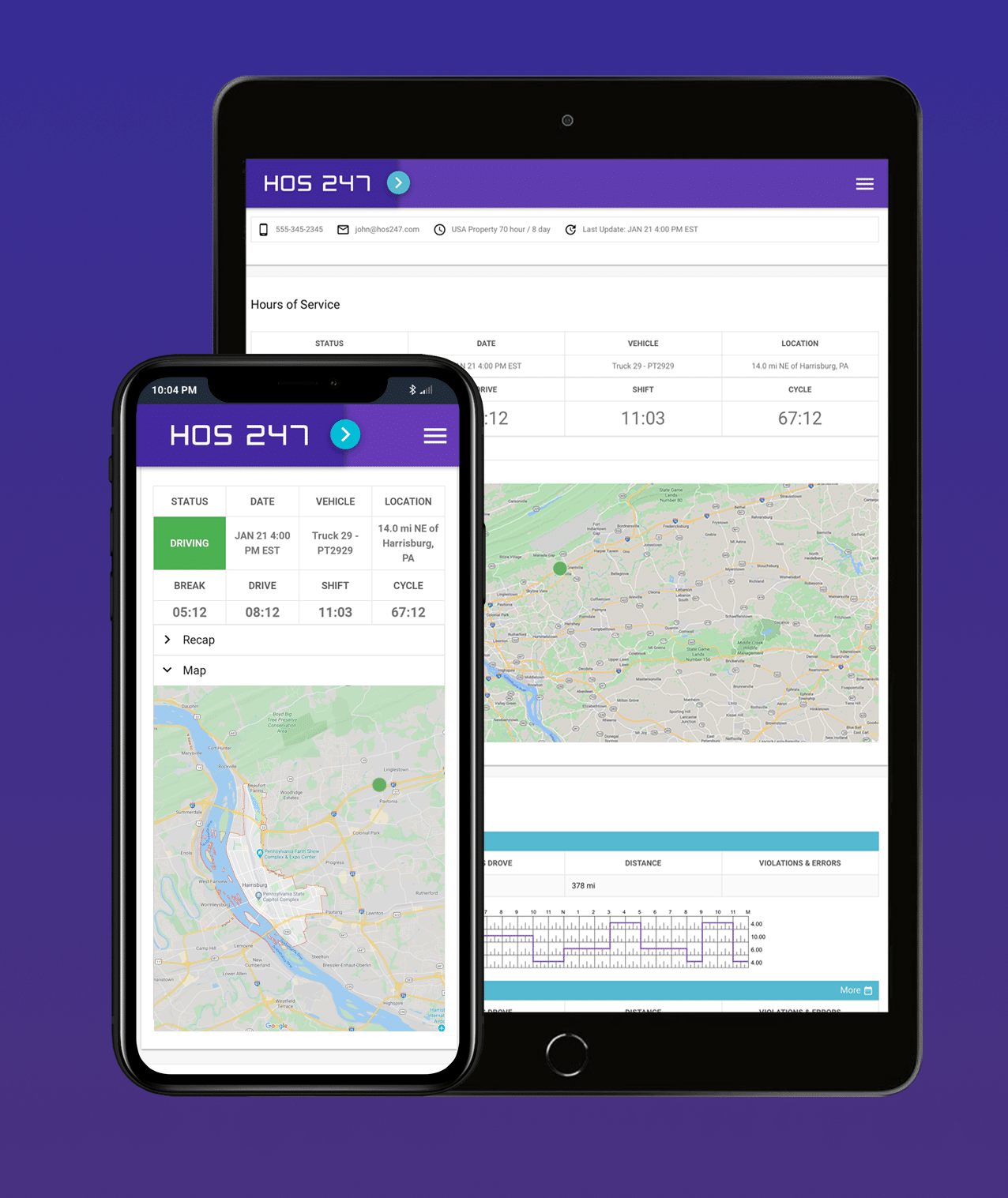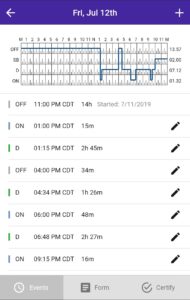Hours of service (HOS) regulations are one of the key components behind commercial trucking today. They set limits on how long commercial motor vehicle (CMV) drivers can drive before having to take mandatory rest.
These rules address driver fatigue, which is a major cause of commercial vehicle accidents. By limiting driving hours and requiring mandatory rest, HOS rules make the roads safer for everyone.
Transport Canada requires the use of electronic logging devices (ELDs) for federally-regulated commercial carriers from January 1, 2023. Unlike paper logs, ELDs automatically record driving time and help stay compliant with CMV driver hours of service regulations.
In this article, we will walk you through the HOS requirements for CMV drivers and explain how ELDs help drivers and fleets stay compliant. We’ll also cover practical implications of HOS regulations, handling common challenges in compliance, and tips for turning compliance into a professional advantage. Whether you’re an owner-operator or manage a fleet, staying informed on these matters and choosing a quality electronic logbook is essential for safety, compliance, and running a successful operation.
Do you have any questions? Talk to ELD Advisor: 650-405-3372 or Request Callback
What Is a CMV Driver?
Before diving deeper into the specific requirements of HOS regulations, we need to establish who qualifies as a CMV driver under Transport Canada guidelines. By definition, it is someone operating a vehicle used for business purposes that meets criteria set by federal regulations, which we’ll discuss below. Not all drivers who transport goods commercially fall under these regulations. The classification depends on the vehicle’s characteristics and how it’s used.

What Qualifies A Vehicle as A CMV?
According to the Canadian commercial vehicle drivers HOS regulations, a vehicle is considered a CMV if it meets any of these criteria:
- Has a gross vehicle weight rating or gross combination weight rating of 4,500 kg (approximately 9,921 pounds) or more.
- Is designed or used to transport more than 10 passengers (including the driver).
- Transports hazardous materials in quantities that require placards under the Transportation of Dangerous Goods regulations.
This distinction matters because many people might drive commercial vehicles without technically falling under the CMV classification that requires compliance. When we consider who needs to comply with Canadian HOS regulations, it’s important to remember that CMV hours of service rules apply to drivers who:
- Operate vehicles that match the CMV definition above.
- Drive across provincial or territorial boundaries (interprovincial commerce).
- Transport cargo or passengers within provincial boundaries (intraprovincial commerce) in provinces that have adopted the federal regulations.
Some provinces have their own HOS regulations that may differ from federal rules for intraprovincial operations, but interprovincial commerce falls under federal jurisdiction. There are a few key reasons why HOS rules apply specifically to CMV drivers and not all commercial drivers.
One of such factors is safety, since larger vehicles pose greater risks in accidents due to their weight, size, and potential impact. Vehicles carrying passengers or hazardous materials also require stricter safety standards. Another factor is driver health: extended hours behind the wheel of large commercial vehicles cause greater fatigue than in smaller vehicles. Besides, the federal government regulates commerce that crosses provincial borders, which many CMV operations engage in.
Breakdown of HOS Regulations for CMV Drivers
Understanding the specific rules on driving time is essential for any driver. They are designed to prevent fatigue while allowing drivers to do their work efficiently. Let’s break down these rules in detail.
Driving Time Limits: South of 60° North Latitude vs. North of 60° North Latitude
Transport Canada sets different driving limits depending on where in Canada drivers operate. For drivers operating south of 60° north latitude:
- May drive up to 13 cumulative hours in a day after 8 consecutive hours off duty.
- Drivers cannot drive after accumulating 14 hours of on-duty time in a day.
- All driving must be completed within a 16-hour window that starts when the driver comes on duty.
- Drivers must take at least 10 hours of off-duty time each day, with at least 8 of those hours being consecutive and the remaining 2 hours must be taken in blocks of at least 30 minutes each.
For drivers operating north of 60° north latitude (Yukon, Northwest Territories, Nunavut):
- May drive up to 15 cumulative hours in a day.
- Drivers cannot drive after accumulating 18 hours of on-duty time in a day.
- All driving must be completed within a 20-hour window.
- Drivers must take at least 8 consecutive hours of off-duty time.

Rest Breaks & Weekly Limits: Daily Off-Duty Time and 70/120-Hour Rules
Here’s a clear summary of rest breaks and weekly limit rules for drivers in Canada. They help stay compliant, manage fatigue and keep everyone safe on the road.
- Unlike the US 30-minute break requirement, Canadian regulations focus on daily off-duty time: minimum 10 hours off-duty time per day, with at least 8 consecutive hours.
- If operating on a normal 7-day cycle, drivers cannot drive after being on duty for 70 hours in any 7-day period.
- If operating on a 14-day cycle, drivers cannot drive after being on duty for 120 hours in any 14-day period, and must take at least 24 consecutive hours off before reaching 70 hours of on-duty time.
- Drivers can reset their cycle by taking 36 or more consecutive hours off duty for Cycle 1, or 72 or more consecutive hours off duty for Cycle 2, which is known as the “cycle reset.”
Following these rules helps drivers stay alert and compliant with regulations. Taking proper breaks and respecting weekly limits is important for the safety and efficiency of all parties involved.
Special Provisions and Exceptions
According to the Canadian sleeper berth provision, drivers can split their required 8-hour off-duty period into two periods in a sleeper berth. Each period must be at least 2 consecutive hours. The total of the two periods must be at least 8 hours. Additionally, drivers must take 2 more hours of off-duty time in blocks of at least 30 minutes each.
The adverse driving conditions exception allows drivers to extend their maximum driving time by up to 2 hours when unexpected conditions affect operations. This may include unexpected weather events, accidents, or road closures. The key here is that the condition must not have been known before the driver began driving. In declared emergency situations, Transport Canada regulations provide temporary regulatory relief for CMV operations. These exceptions are typically announced by Transport Canada when emergencies occur.
Drivers who operate within a 160-kilometer radius of their home terminal may qualify for the “local” exemption, which gives more flexibility with logbook requirements, though they must still maintain time records and comply with daily and cycle limits. In such a case, time records showing start time, end time, and total hours worked must be maintained.
For oil and gas industry operations, there are specific exemptions that allow for modified duty status reporting and cycle management due to the unique nature of well service operations.
Additionally, the Canadian regulations provide specific exemptions for utility service vehicles, emergency vehicles, and specific agricultural operations. For agricultural operations, provincial regulations may provide additional exemptions during planting and harvesting seasons. Always verify with the provincial ministry of transport to avoid compliance issues.
Understanding these CMV hours of service rules and their exceptions is key for maintaining compliance and maximizing efficiency. While these regulations might seem complex, they’re designed with driver safety and wellbeing as the main concern.

Practical Implications of HOS Regulations
Understanding the law is one thing, but successfully applying rules to real-world driving situations is what truly matters. Let’s explore the regulations’ impact on daily operations and strategies for working within these parameters.
Trip Planning & Scheduling Tips
When it comes to strategic route planning, consider traffic patterns — morning and evening rush hours in major cities can impact the available driving hours. Use weather forecasting tools to anticipate potential delays. Identify safe parking locations along your route before you depart, especially near the projected driving limit or on-duty window boundaries. Build in buffer time for unexpected delays like road construction or accidents to avoid HOS violations.
As for load planning, coordinate with shippers and receivers to arrange appointment times that align with your available hours. When possible, schedule loading/unloading when you’d be taking required breaks. For multi-stop routes, calculate cumulative driving and on-duty time carefully to ensure compliance throughout the trip. Remember that loading and unloading counts against your 16-hour window but not your 13-hour driving limit.
To manage consecutive days better, track your 70-hour (Cycle 1) or 120-hour (Cycle 2) limits when planning multiple-day trips. Strategic placement of the 36-hour restart (for Cycle 1) or 72-hour restart (for Cycle 2) can maximize available driving time for the week as well. Consider how sleeper berth provisions might be used to optimize your schedule while still getting adequate rest.
As for documentation and communication: make it clear to dispatchers what your available hours are. Keep accurate records of any unexpected delays that might qualify for exceptions, and document adverse driving conditions if you need to use that exception.
Fatigue Management Strategies
Let’s consider some non-compliance tips. Since HOS regulations establish minimum rest requirements, additional rest is very important. To feel truly well-rested, aim for 7-8 hours of quality sleep during off-duty periods.
To get the most out of your time off, use your off-duty time blocks for rest, not just additional work tasks. Short naps (about 20 minutes) can really help against drowsiness. Light physical activity during breaks can help you stay alert as you return to driving.
Maintaining a comfortable cabin temperature also makes a difference: when it’s too warm, drowsiness is more likely to strike. Ventilate the cabin to stay alert and use audio content to keep your mind focused. Canadian winters present additional challenges, so prepare for extreme cold with emergency supplies and plan for reduced speed and visibility in winter driving conditions.
HOS regulations may sometimes feel restrictive, but together with fatigue management practices, they encourage sustainable and safe driving.
Using ELDs for HOS Compliance
Electronic logging devices do much more than just record hours. They actively help manage time on the road with precision and ease. By syncing directly with the truck’s engine, ELDs automatically capture driving time whenever the vehicle is moving above 5 mph. This hands-free tracking removes guesswork and reduces the risk of errors or missed logs.
But it’s not all automatic — drivers still play a key role. Statuses like on-duty not driving, off-duty, and sleeper berth have to be logged manually since these can’t be detected by the engine. This collaboration between driver input and automated tracking creates an accurate picture of work hours.
One of the biggest advantages of modern ELDs is their real-time alert system. These notifications help plan the workload better, avoid violations, and stay compliant without the stress of constantly watching the clock.
When it comes to inspections, ELDs simplify the process dramatically. They securely store records for at least 8 days and can quickly transfer logs to enforcement officers via wireless web services, USB, or Bluetooth. With built-in backup systems, the duty status data stays safe and accessible even if the logging device experiences a glitch.
Benefits of ELDs Beyond Compliance
The main benefits of ELDs that go beyond compliance are:
- Operational efficiency. Electronic logs eliminate paperwork, saving drivers time that can be allocated to other tasks. They can track your IFTA kilometers automatically, give dispatchers real-time info to make better decisions, and make vehicle inspections easier.
- Improved safety outcomes. ELDs help manage driving hours better, which reduces driver fatigue. Since they became mandatory, fewer drivers break hours-of-service rules, and crash rates have gone down. Drivers who follow these rules stay healthier and more alert.
- Financial benefits. Using elogs lowers the chance of fines and violations, can reduce insurance costs, improve fuel use, and cut down on crash-related expenses and downtime.
- Driver protection. ELDs lower the pressure to falsify logs, provide proof of hours worked in case of disputes, help drivers refuse unsafe driving requests with clear data, and record detention time at loading and unloading sites.
Selecting the right ELD solution is crucial to get all these benefits while ensuring compliance. The system should be user-friendly and reliable, and have responsive customer support to address any issues that arise on the road.
HOS247 ELD Solutions for CMV Drivers
Finding the right ELD partner can make a real difference in your daily operations and long-term success. When it comes to managing expectations, not all ELD providers deliver the same experience. HOS247 has built a reputation as a trusted ally for fleets and owner-operators, delivering not just compliance, but real advantages for drivers and fleet managers alike. Here’s how HOS247 stands out:

- Top-rated support. A multilingual customer service team (English, Spanish, Russian, Polish) with live representatives available 7 days a week.
- Driver-friendly interface. Intuitive app design, simple status changes with just a few taps, clear visual indicators of remaining hours, and easy edits for non-driving duty status changes. Works on both iOS and Android devices.
- Reliable hardware. Durable components built for demanding environments, stable Bluetooth connection between engine device and driver’s tablet/smartphone, backup cellular connectivity, and consistent performance.
- Flexible options. No contract plans available – pay monthly or yearly without long-term commitment. We also offer scalable solutions for both single trucks and large fleets, and bundle options with:
- Real-time GPS fleet tracking. Instantly locate vehicles, optimize routes, and improve delivery reliability with advanced GPS tracking. This boosts security and helps reduce fuel consumption by minimizing unnecessary miles.
- Automatic IFTA calculations. HOS247 automatically tracks and reports kilometers by province and territory, saving time and reducing errors.
- Seamless integration. Our solution integrates with leading fleet management and dispatch systems, providing a unified platform for compliance, tracking, and business operations.
- Preventive maintenance and diagnostics. When integrated with our GPS tracking feature, the system monitors vehicle health, alerts you to fault codes, and helps schedule maintenance before problems lead to breakdowns, keeping your fleet running.
- Idle monitoring. Track idle time, identify fuel waste, and improve efficiency and lower operating costs.
- Inspection-ready. Inspection Mode lets you show logs directly from your device, making roadside checks quick and hassle-free-no-printer required.
- Comprehensive compliance tools. Automatic HOS calculations, violation alerts, and support for Canadian HOS rules (including cycle 1 and cycle 2 operations, as well as special provisions for operations north of 60°) help you stay compliant no matter your operation.
- Easy returns. Test the system risk-free with a two-week trial. If it’s not the right fit, return it in a few simple steps.
With a focus on compliance, reliability, and responsive support, HOS247 helps you stay efficient and confident on the road. Whether you’re an owner-operator or manage a large fleet, our solution delivers the necessary features to keep your business moving forward.
How HOS247 Helps with Compliance
Our system automatically tracks all CMV hours of service rules, includes built-in exceptions, updates with changing Transport Canada regulations, and offers US rule sets for cross-border operations. It provides one-click data transfer for inspections, simple display mode for officers, automatic log backup, and detailed violation alerts with prevention guidance. Real-time visibility of driver hours, proactive violation notifications, historical compliance reporting, and safety-focused performance metrics are also included. HOS247 features free installation assistance, driver training resources, administrator dashboard tutorials, and regular regulatory update webinars.
Selecting HOS247 for your ELD needs means choosing a partner committed to keeping drivers compliant with CMV hours of service regulations while making the process as painless as possible. Our focus on exceptional support ensures that help is easily available when challenges occur.

Addressing Common Challenges in HOS Compliance
Even with clear regulations and reliable ELDs, commercial drivers frequently encounter situations that make compliance challenging. Understanding how to handle these common scenarios is important for maintaining a clean record.
Dealing with delays and tough conditions on the road is part of the job, but how they’re handled can make a big difference. Here are some tips to help you stay compliant and make the most of your time:
- If you’re waiting at a shipper or receiver, make sure to log detention time as “on-duty, not driving.” Keep your dispatcher informed, and check your company’s policies about detention pay. When possible, use this downtime to take your required breaks.
- When stuck in traffic, consider using the split sleeper berth provision to manage your hours. If traffic is really bad, see if the situation qualifies for the adverse driving conditions exception. Planning alternate routes and building in extra time for high-traffic areas can help you avoid running short on hours.
- Safety always comes first, especially in bad weather. If conditions are unsafe, slow down or stop, and make sure to document the situation carefully. Stay in touch with dispatch, and remember that only unexpected weather counts for the adverse driving exception.
- If your truck breaks down, record the time spent dealing with repairs and keep notes on what happened. Let your dispatcher know right away so you can figure out new delivery plans.
Handling these situations well helps keep you safe, protects your hours, and shows your professionalism on the road.
Canadian Jurisdiction Requirements
Federal rules apply to all interprovincial commerce, while intraprovincial operations follow province-specific rules. Crossing provincial borders subjects you to federal regulations, though most provinces have adopted federal HOS rules with some modifications.
Drivers performing both interprovincial and intraprovincial operations must follow the applicable rules for each portion of their trip. They must document which rule set applies to each portion, manage logs carefully when switching between rule sets, and configure ELDs to both federal and provincial rules.
The key to navigating these challenges lies in knowing the regulations, communicating with dispatch and customers, and documenting exceptional circumstances. With a reliable ELD system like HOS247, drivers can maintain compliance even in unexpected situations.
Tips for Staying Compliant with HOS Regulations
Maintaining consistent compliance isn’t just about avoiding violations; it helps develop habits that make compliance second nature. Here are best practices that CMV drivers use to stay on the right side of HOS rules:
- Stay updated on regulations. Review current HOS rules periodically, follow Transport Canada announcements for rule changes, and join professional driver groups for compliance discussions.
- Perform regular self-checks. Review your logs weekly for patterns or compliance issues, compare logs with supporting documents like fuel receipts, and address discrepancies before inspections.
- Use your ELD strategically. Check available hours at the start of each shift, monitor the work window throughout the day, treat violation warnings as prevention tools, not just alerts.
- Document everything. Note unusual circumstances in your log remarks, keep supporting documents organized for at least 8 days, and record details when using exceptions.
By incorporating these best practices into your daily routine, compliance with CMV hours of service regulations becomes less of a burden and more of a professional advantage.

Conclusion
Understanding and following regulations is essential for safety, compliance, and operational success. Modern ELDs, particularly user-friendly solutions like those offered by HOS247, help truckers stay compliant and use the data to improve their bottom. For fleet managers and owner-operators alike, selecting the right ELD partner is a crucial decision.
While technology can help track hours, proper planning, good communication, and professional judgment also play an important role. By developing consistent habits around log management, trip planning, and rest scheduling, drivers can maintain compliance while maximizing productivity.
Safe, compliant operations benefit everyone on the road. By understanding and following CMV driver hours of service rules, using quality ELDs, and implementing best practices, commercial drivers contribute to a safer transportation system while protecting their livelihoods and the future of the industry.

As an expert in B2B and B2C sales, I’ve dedicated myself to perfecting sales processes and client retention strategies in the logistics and trucking industry. I have significantly contributed to the expansion of the ELD service, catering to retail and wholesale clients in need of HOS247 ELD solutions. My unwavering commitment to implementing state-of-the-art sales techniques and technologies ensures the continuous growth and success of businesses I work with.












After several enforcement delays, the Canadian ELD mandate was fully implemented on January 1, 2023. Much like the elog rule in the US, Transport Canada ELD regulations now require commercial vehicle drivers to record their hours of service using an

Truckers who integrate all in one ELD fleet management systems to their businesses can significantly improve their operations by achieving compliance with the elog law while optimizing essential workflows. These systems streamline processes such as route planning, dispatch, vehicle maintenance,

Transport Canada has issued standards for drivers, fleet managers, and owner-operators to consider when they choose a vehicle log book. Electronic logbook providers must follow these standards for their devices to be certified by a Transport Canada approved accreditation body.